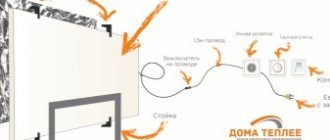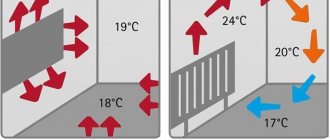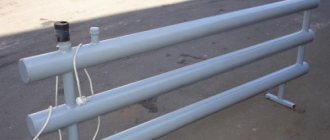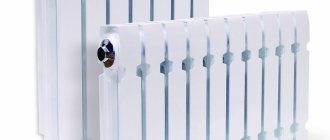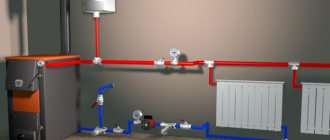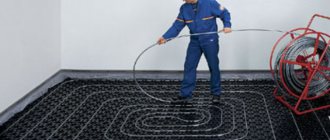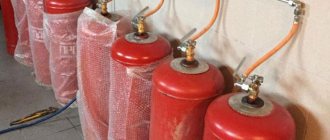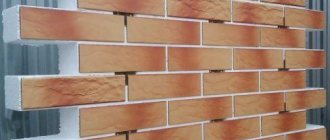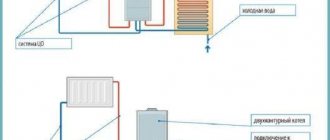An infrared heater is an effective and economical device for heating rooms. Equipment of this type allows you to create coziness and comfort in domestic and industrial conditions. Keep in mind! The device in question is a heating device powered by electricity. Infrared heaters are a relatively new type of climate control technology. Their work is based on the radiation of infrared waves, which heats not the air, but directly objects and surfaces. Such devices are characterized by a high level of efficiency. They are universal, safe to use, thanks to which they can be used in various rooms, and do not burn oxygen. Let's look at how to choose the right device and give a rating of the best infrared heaters.
The operating principle of such a heater is based on the action of the energy of infrared rays, which heat not the air, like traditional heating systems, but the surrounding objects. The latter, in turn, release the resulting energy into the environment. Most models of infrared heaters have a metal body coated with heat-resistant enamel, a heating element, a thermal insulator, a protective screen, fastening elements, and a power indicator light. Some devices are equipped with a thermostat that can be used to regulate the temperature in the room.
Types of infrared heaters
There is a huge range of infrared heaters on the market. They are usually divided according to installation method into:
- Floor-standing
- Wall mounted
- Ceiling
Floor infrared heater
Floor heaters are extremely versatile. They are often used as an additional heat source, suitable for installation in apartments, houses, offices, garages and so on. Their main advantage is mobility; the device can be turned in the right direction at any time. In addition, many floor-standing devices have a rotating housing. Models vary significantly in power, design and size. They can be horizontal, vertical or cylindrical.
Wall-mounted infrared heater
Wall-mounted infrared heaters are installed permanently, which means they are suitable for constant heating. Flat models, made in the form of a panel, are not very noticeable and fit well into the interior.
Infrared heater for ceiling mounting
Ceiling heaters do not take up useful space. The scope of their use is quite wide. They are suitable for both domestic and professional use. Such heaters can be installed in greenhouses, car repair shops, workshops, and saunas. When choosing such a device, special attention should be paid to the maximum ceiling height.
Some infrared heaters are universal. Such models are suitable for floor, wall or even ceiling installation.
Features of IR ceiling heaters
A ceiling infrared heater is a heating device that converts electrical energy into heat during operation. The transfer of thermal energy is carried out using a directed flow of long-wave infrared radiation to different surfaces or objects located in the range of the device. Thus, these types of radiation contribute to heating not the air itself, but the objects in the living room.
Advantages of ceiling-mounted electric infrared heaters
Before purchasing a new generation ceiling infrared heater, it is recommended to first study all its strengths and weaknesses. If we consider the advantages of heaters mounted to the ceiling surface, we can highlight the following points:
due to the high level of thermal energy output, ceiling infrared heaters have a high positive impact coefficient; the room warms up to the desired temperature as quickly as possible; high level of fire safety, which is very important for residential and technical premises; these models are mobile; infrared heating devices operate silently; the level of electrical energy savings varies from 40% to 60%; if necessary, you can set the focusing of the radiation; Some models are equipped with the ability to heat the room to the required temperature and subsequently maintain it.
Infrared heaters installed on the ceiling can be installed independently, without the help of specialists.
Disadvantages of infrared ceiling panels
As practice shows and reviews from consumers who have managed to use and appreciate the performance of infrared heaters installed on the ceiling, these heating devices do not have any drawbacks. Despite this, on the Internet you can find reviews from dissatisfied consumers who speak negatively about new generation infrared heaters. As you know, negative reviews are directly related to improper operation of the equipment. This is due to the fact that the conditions in which infrared heat sources operate do not meet the standards:
- the walls of the living space are poorly insulated or not insulated at all, as a result of which all the heat disappears quite quickly;
- there are a large number of holes in the walls, which also contribute to the rapid cooling of the living space, as a result of which the operation of the heater becomes invisible;
- rather thin walls in the room;
- the door is always open.
Before purchasing this type of heating device, you must first check the thermal insulation, otherwise the expected result may not be felt at all.
Application scope of infrared ceiling heating
Infrared ceiling heating devices, as a rule, are used for heating not only residential premises, but also for industrial purposes. Such heating devices can be used as the main or additional source of heat. Depending on the goals, choose the power level. Experts recommend choosing power with a small margin, taking into account possible heat losses during equipment operation.
Types of heating elements
The infrared heater can operate on the basis of the following types of heating elements:
- Halogen
- the design contains a halogen lamp. Its filament is made of tungsten or carbon fiber. Such devices generate not only heat, but also light. The main disadvantage of the devices is the harmfulness of short infrared waves, which means it is not recommended to use halogen heaters in residential areas. - Carbon
- such heaters are equipped with a quartz tube, inside of which there is a carbon heating coil. Such devices are characterized by high efficiency. Their disadvantage is high energy consumption and short working life. The service life of the heater usually does not exceed 2 years. - Ceramic
- devices with such a heating element do not glow and are highly durable. Among their advantages, it is worth noting absolute harmlessness and low energy consumption. - Micathermic
heating elements are similar to ceramic ones. They are made of metal tubes and are recommended for use in residential areas. The downside of the devices is the characteristic crackling sound during use.
Infrared heaters can be powered from an electrical power supply or liquefied gas. Electric models are the most common and can be connected to a single- or three-phase network. They are used to provide heat to homes, offices, workshops, and industrial premises. Gas heaters are less common. Most often they are used for heating open terraces, work areas, and greenhouses.
The thermal power rating indicates the area for which the heater is designed. For 10 sq.m. The premises should have 1 kW of thermal power. So for heating a room of 30 sq.m. will require a heater of at least 3 kW. If the device is used as a source of additional heat, each “square” can account for 0.6 kW.
The number of heating modes depends on the heater model. The more of them, the more flexible the device’s settings.
Devices in the lower price category are controlled by a mechanical panel with buttons and a rotary control. More expensive models are equipped with a timer and thermostat. The latter provide protection against overheating and allow you to maintain the temperature at a given level. Expensive devices are often equipped with a display, touch control panel and remote control.
Infrared heaters come in three types:
- electric - they are most often used for heating residential or office premises. There are ceramic (in the form of a panel), carbon (with a tubular element) and film, characterized by flexibility and ease of installation;
- gas - such models use gas fuel as a power source. They are installed in production, in workshops and outdoors. Such devices are large in size and have excellent thermal power;
- diesel (or kerosene) - they are used for drying wood or during the construction of large objects to dry coatings. In terms of power they are close to gas ones, but much more compact in size.
By radiation range
If we consider IR heaters by radiation range, the following types are distinguished - short-, medium- and long-wave. What is the reason for this?
The heating elements that are located inside can produce different wavelengths and also have different heating temperatures.
Let's take a closer look at each type:
- Long-wave - devices emitting waves with a length of 5.6-100 microns. The temperature is in the range of 100-600 degrees Celsius. Scope of application: house, apartment, offices and other objects where the ceiling height does not exceed 3 meters. If we are talking about an apartment, a product with a temperature of up to 150 C is enough to heat it.
- Medium wave - heating elements having a wavelength in the range of 2.5-5.6 microns. The operating temperature is higher - 600-1000 C. Heaters with such radiation are used in office premises, homes, industrial buildings and other facilities where the ceiling height is 3-6 m. This can be an administrative building or a private home.
- Short-wave - elements for heating with a wavelength from 0.74 to 2.5 microns. Temperature - from 100 C. The ceiling height should be more than 6-8 m. Such infrared heaters are used in a factory or factory workshop and can be useful in open areas.
Comparing technologies
The first thing that always worries the consumer is the cost of the device. For oil heaters-radiators and infrared heating devices, the prices are almost the same. However, for a little over three thousand domestic rubles you can purchase a fairly powerful and functional oil radiator, designed to heat a room with an area of 20 m2, or a carbon IR heater, with a radiator service life of about 2 years, minimal functionality, with a heating area of up to 12 m2.
Conclusion 1: in the ratio of cost - functionality - efficiency, the oil heater won.
The second is electricity consumption. An oil radiator and an IR heater require different power to heat the same rooms. Based on this, infrared heating devices consume 30–50% less electricity than their oil-based competitors.
Conclusion 2: IR heating devices win in terms of efficiency.
Third is operational safety. IR models can cause fire in objects located within 0.5 meters of the emitter. Carbon and halogen emitters will instantly fail if exposed to moisture. An oil cooler is safe. The surface temperature rarely exceeds 90°, so such a device is not capable of heating the surface of interior items before it ignites. In addition, such a device is not afraid of water and lack of air circulation: if it overheats, the security system will simply stop supplying power to the device.
Conclusion 3: From a safety point of view, IR heaters are inferior to radiators
Fourth is the heating speed. An oil heater requires (on average) 30 minutes to reach full power. Infrared models begin immediately after switching on to heat objects and surfaces of enclosing structures.
Conclusion 4: Infrared heating devices heat the room much faster.
So, according to the main criteria, parity is maintained between these devices. Both types of devices are suitable for creating and maintaining the desired temperature. That is why the decision of which heater to buy, a budget oil heater or an expensive infrared one, depends entirely on the characteristics of the room and the preferences of the buyer.
Heating a room faster with an infrared heater
Some tips for choosing a heater for your home
Decide on the location of the device. The performance of the device and, to a large extent, the heating efficiency will depend on this. Oil models are bulky; IR heaters are drop-resistant and require a specific installation method
Based on this, experts recommend paying attention to wall-mounted models. The efficiency of the device largely depends on its power. To correctly select an oil radiator, you need to focus on the following figures: 1 kW per 10 m2 of area
To calculate the required power of an infrared heater, use the following algorithm: 0.5 kW per 10 m2 of heated area. The device control system can be mechanical or electronic. Models with a mechanical system are much cheaper, but have a lot of disadvantages: rapid wear, limited functionality, high percentage of errors. Models with electronic control are expensive, but do not have these disadvantages and open up a lot of additional opportunities for the user. The surface of oil radiators can heat up to significant temperatures. If there are small children in the room, it is recommended to purchase models with a protected design, where the surface of the radiator is protected by a tubular frame that prevents contact with the device. When choosing an IR heater for a room with children, pay attention to micathermic models, the heating element of which emits thermal energy, but practically does not heat up.
Watch a video comparing heaters
How to choose an infrared heater
Here the future location of the device plays a major role. Based on this, buyers usually choose whether to purchase a floor, wall or ceiling heater. In terms of operating efficiency, there is no big difference between halogen, carbon and quartz units, so in this sense, the choice is largely influenced by the brand and price of the heater. Choose the best, and our rating will definitely help you with this.
Like any other heater, infrared (IR) is selected based on performance - thermal power.
On average, per 1 sq. m. room should account for 100 W. For colder buildings, and also if the heater is the only source of heating – 120-150 W. And vice versa - if the thermal insulation of the home is good or there are other heat sources, you can choose less efficient equipment (60–80 W per 1 sq. m.).
Depending on the design and type of installation, IR heaters can be ceiling, wall or floor mounted. Their cost and performance are also affected by additional options: thermostat, remote control, built-in humidifier and others.
Device and principle of operation
The first carbon heaters appeared in Japan back in 2000, they ran on electricity.
Based on many tests carried out, it can be stated that this device does not pose any threat to human health. The role of the heater is played by carbon fiber placed in a special quartz tube with a vacuum. It is this design that is the real “highlight” of carbon heaters, which are fundamentally new types of structures.

Infrared carbon coil used to make a lamp
Their main difference from traditional heaters is not only their higher technical and economic indicators, but also the fact that they do not dry the air and do not burn oxygen. Like all heaters, carbon devices cannot but have disadvantages, which will be discussed a little later.
A carbon heater with a power of 1 kW is not inferior in its parameters to the operation of an oil radiator with a power of 2.1 kW. In essence, a carbon heater is a long-wave emitter that heats not the air, but objects encountered in its path, which then transfer heat to the air, providing the most comfortable microclimate in the room.
If you take into account the peculiarities of the heater’s operation, you need to remember that objects do not heat up, but are only warmed up under the action of the emitter to a depth of 2-2.5 cm. The role of the heater is played by carbon fiber placed in a quartz tube with a vacuum.
The heater works even at sub-zero temperatures, delivering vital warmth in just a couple of minutes. If compared with traditional devices, they are not able to operate at sub-zero temperatures. Carbon fiber has a much higher thermal conductivity than the metal used in traditional heaters in the form of a heating element. That is why carbon heaters consume 2.5 times less electrical energy compared to other heating units we are used to, which makes it possible to significantly relieve the load on networks.
Experts say that carbon fiber does not have a service life, since it does not wear out at all, while metal is subject to aging and corrosion. Another important design feature is the ability to rotate the device 70 degrees, which makes it possible to increase the heated area.
A carbon infrared heater can be classified as a long-wave heater; therefore, its main advantages are the preservation of oxygen without reducing air humidity. The device has fairly simple controls that anyone can handle. The presence of a power regulator makes it possible to control the temperature in the room depending on the influence of external factors.
The best manufacturing companies
Since the demand for infrared heaters is growing every year, a large number of companies have appeared that produce this climate control equipment. Some companies have been around for a long time, others are only in the process of development.
- BALLU is an international holding company for the production of industrial and home climate control equipment. The company's headquarters is located in Hong Kong; there are representative offices in Russia, Poland, and a number of Asian countries. Specializes in technologically advanced and relatively inexpensive climate control devices. All have a laconic stylish design, simple controls, and high efficiency. Innovative technologies and eco-materials are used in production. IR heaters from BALLU are used to heat rooms of various sizes and purposes; most of the products are wall and ceiling models.
- Almac is a domestic company that mainly produces ceiling-mounted IR heaters. The manufacturer focuses on ease of installation, high-quality materials, and device safety. Most IR heaters from Almac are suitable for homes, cottages, greenhouses and garages, have good power and are quite compact.
- NeoClima is a European brand from Greece that produces high-quality climate control equipment. The company is known for its latest technological equipment, innovative approach to production and a huge network of enterprises around the world, including in Russia and the CIS countries. NeoClima IR heaters are open and closed ceiling models, including home and office ones.
- Timberk is a Swedish holding company producing various types of household appliances. In the manufacture of climate control equipment, high quality requirements are imposed; all devices are tested for compliance with international standards. IR heaters of this brand are available for installation on the ceiling or wall; there are also portable models. Almost all devices are equipped with a remote control for ease of operation.
- ZUBR is the largest Russian manufacturer of construction products, which also produces climate control equipment. The company has a wide range of heat guns, but there are also models of infrared heaters. The company's developments are constantly being improved, the production process is controlled at all stages.
Installation of infrared heating film
In order for heating using IR film heaters to work effectively, certain requirements must be met during installation:
- First of all, it is necessary to insulate windows, walls and doors. Installation of insulation is not allowed in conditions of low temperatures and high humidity.
- When it is planned to use infrared heaters as the main heating system, they should be placed on the ceiling or floor so that their rays cover about 80 - 90% of the room area. If IR devices will be used additionally for heating, then no less than 40%.
- The power supply must correspond to this value specified in the product passport. If it is not enough, then you need to install a special unit with which you can redistribute the voltage across the rooms, taking into account the required temperature conditions in each of them.
- The temperature sensor should be mounted at a certain height. When the heater is a floor type, then this sensor should be located at a height of 10 to 15 centimeters, and if it is a ceiling type, then it should be placed at a distance of 170 centimeters from the floor surface. When choosing a standard ceiling model, it is recommended to place it in rooms with a ceiling height of no more than 3.6 meters, otherwise energy costs will be significant.
- In order to reduce heat loss, experts advise installing infrared heaters on top of a foil film that reflects radiation in the direction of the premises. Do not connect the film heater to the power supply for testing while it is in the roll.
- By the way, a rolled infrared heater can be cut into several parts, but only following the lines specified by the manufacturer of this product. The length of one section should not exceed 8 meters, and the distance between stripes cannot be more than 0.5 centimeters.
- It is also prohibited to bend infrared film heaters at right angles. To fix them, use special fasteners or a stapler. When carrying out installation work, you need to make sure that they are located on the transparent areas of the film.
Wall-mounted infrared heaters
Wall-mounted heaters also do not take up much space and are suitable for both primary and additional heating of rooms. They can be placed next to your desk or sofa for localized effects.
Nikaten NT 500

It is capable of completely heating a room of 10 square meters. The design promotes uniform heat distribution. The height of the heater is only 40 cm, so it can be installed under a window. Characteristics:
Thermal power - 500 W;
Number of operating modes - 1;
Thermostat - yes;
Control is mechanical.
Advantages
- Pleasant appearance;
- The wall at the installation site will not overheat;
- Economical energy consumption.
Flaws
- None.
KALASHNIKOV KIRH-E10P-11

It can be used in various premises, both domestic and industrial, and is safe for human health. The housing with protection class IP20 is made of anodized aluminum. The installation procedure has been simplified and a swivel bracket has been installed. The design includes a mineral filler that protects against overheating. Characteristics:
Thermal power - 1000 W;
Number of operating modes - 1;
Control is mechanical.
Advantages
- Durable aluminum housing
- Stylish appearance
- Fast heating
- Moisture protection of the case
- High build quality
Flaws
- None
Hintek IW-03

The model has economical power consumption - 300 W. The finned back panel promotes even heat distribution. The surface of the heater heats up to a temperature of no more than 70 degrees. The design provides protection against overheating and moisture protection of the IP54 class housing. Characteristics:
Power - 300 W;
Number of operating modes - 1;
Protective functions - shutdown when overheating;
Control is mechanical.
Advantages
- Simple controls
- Laconic design
- Fast heating
Flaws
- Low power
Hyundai H-HC2-40-UI693

High power and increased dimensions make this heater suitable for large rooms. It can be used not only as an additional, but also as the main type of heating. In addition to wall installation, the model also provides for ceiling installation. Hyundai H-HC2 is suitable for semi-open spaces and can be used as a small thermal curtain. The IR heating element is hidden behind the body, which prevents burns. The equipment does not emit visible light, operates silently and does not dry out the air. Made in Russia, the homeland of the brand is South Korea.
Advantages
- High power
- Silent operation
- Hidden heating element
- Working in semi-open spaces
- Universal installation
Flaws
- No remote control
Ballu BIH-LW-1.2

A compact heater from a Dutch manufacturer perfectly copes with its purpose in any room - with low and high levels of insulation. The built-in quartz lamp quickly heats objects within the range of the device, while emitting a soft orange light comparable to the sun's rays. It is comfortable to be under the heater during the day and evening, but uncomfortable to sleep. Thanks to the built-in bracket, the tilt of the body can be changed within 5 steps in 15° increments. It can be installed at a height of up to 2.5 m, while it has compact dimensions and does not take up useful space in the room.
Advantages
- Outdoor efficiency
- Tilt bracket included
- Compact dimensions
- Fast heating
- Economical energy consumption
Flaws
- Not everyone likes the orange glow
Flaws
Some negative aspects can also be noted:
- uneven heating. If the air heated by a convector or radiator is mixed due to convection and acquires an almost equal temperature within the same height, then the IR heater heats only on one side and in different ways, depending on the distance to it. Because of this, even in a small greenhouse you will have to install at least two devices. Also, due to uneven heating, the user may feel discomfort during the process of caring for the beds - a hot head;
- unpleasant smell when turned on. Occurs due to dust burning on the emitter, which heats up to a high temperature. After a couple of minutes the smell is no longer noticeable;
- lack of opportunity to save by switching to a 2-rate electricity payment scheme. A water heating system with an electric boiler is equipped with a heat accumulator and this makes it possible to turn on the heater only at night, when electricity costs much less (at a 2-rate tariff). This is not possible with an electric IR heater;
- difficulty in connecting devices with large total power consumption. Cables and fittings of electrical networks limit the power of electrical consumers in one household to 7 kW, and in the presence of an electric stove - to 11 kW. This limit can only be increased through expensive substation refurbishment.
As you can see, IR heaters have no significant drawbacks, if only the supplied power supply line allows you to connect the required power.
Powerful infrared heaters for cottages, garages, industrial and utility rooms
Hyundai H-HC4-25-UI710
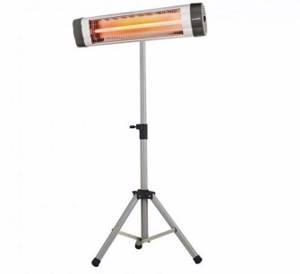
Among the best infrared heaters for a summer residence, you must include the Hyundai H-HC4-25-UI710 model. This infrared heater has earned positive reviews from customers for its good price-quality ratio. Hyundai H-HC4-25-UI710 is designed for wall mounting, for which appropriate brackets are included in the kit. Additionally, you can buy a branded portable tripod with variable height. The model operates almost silently, heats up instantly, and is more economical compared to convection devices. Power – 2500 W, which implies efficiency in areas of 25-30 m². When used in a country house or in a garage where there is no central heating, the indicators are not so rosy, but for directed local heating it’s just right.
Advantages
- Durable metal housing
- Secure wall mounting
- Adjustable tilt angle
Flaws
- No moisture protection
- It's difficult to find replacement lamps
Master TS-3 A
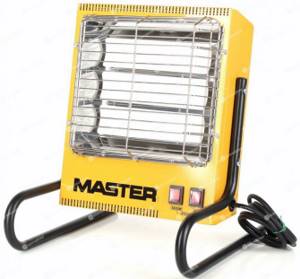
Despite being relatively expensive, this infrared heater from the serious brand Master Climate Solutions is one of the most effective in its class. For dachas, it is relevant primarily due to its good power, reliable performance and maximum efficiency - 100% (at least, that’s what the manufacturer thinks). Constant heating is maintained, there is no burning smell, smoke, or condensation. Oxygen is not burned, forced air flow is not created, and as a result, noise is reduced. Adjustable power – 0.6/1.6/2.4 kW. Just don’t forget about the compliance of the wiring at the connection points. As for the warranty period, by default it is 12 months; when registering with an official dealer, it can be extended to 18, and when carrying out annual paid maintenance by an authorized service center - up to 24.
Advantages
- Strength and reliability of the design
- Unlimited heating element resource
- Production – Italy
Flaws
- High price
- Decent weight – 7.6 kg
Polaris PMH 1584
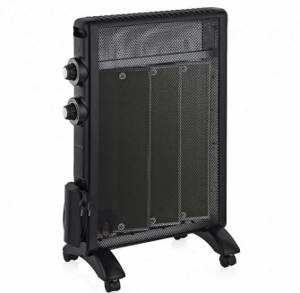
m. Infrared radiation heats surfaces and objects, and convection evenly distributes heat around the entire perimeter, maintaining a comfortable temperature. The micathermic heating element demonstrates high efficiency. The power is adjustable, you can set it to 1500 or 1000 W. Mechanical control, built-in thermostat. Operates from a 220 W network. If the device overheats or tips over, it will turn off. The case contains a compartment for the power cord. The device moves on wheels. Characteristics:
How much area does it heat - 24 sq. m.
How many modes - 2.
The degree of protection is from overheating.
Weight - 3.2 kg.
Advantages
- lightweight, compact
- efficiency
- power adjustment
Flaws
- turns off only from the socket.
Types of picture heaters
Among heaters in the form of decorative panels, you can choose several different options. This applies not only to the image itself, but also to the method of its application and the substrate material.
A picture can be applied to the canvas in two ways:
- Spraying silver particles onto the surface;
- By printing method.
As you can guess from the name, the first option is much more expensive, but the image quality is much better. This is due to the use of higher quality fabrics. The image remains in good condition for many years, it is easy to care for, and the colors remain bright.
Another difference is the border of the image. The canvases of inexpensive models are attached to two horizontal strips made of wood or PVC, which prevent the heater from coming into contact with the wall.
Large-sized paintings-heaters are often framed with a metal or wooden baguette around the entire perimeter, which makes their appearance more presentable.
Advantages and disadvantages of infrared heaters
The main advantages of devices of this class:
- higher efficiency compared to a number of other types of heating systems;
- direct transfer of thermal energy to surrounding objects;
- economical use of electricity;
- rapid heating of the room;
- the ability to focus thermal radiation;
- ability to set the desired heating temperature;
- mobility (applies to portable products);
- ease of installation;
- low noise level during operation.
Common disadvantages of infrared heaters include:
- some models have primitive controls;
- risk of overheating and potential fire;
- effectively heat only locally.
The best heat guns for a summer residence
Efficient heaters with a thermostat for cottages and homes are electric heat guns; their operating principle is fast and intense heating thanks to the heating element. While most conventional convectors provide a passive method of heat transfer, the guns in their design contain rotational elements, which ensure high operating efficiency. Experts analyzed popular models with good user responses on the Internet, tested them and named several leaders.
Wester TV-3/5
The first thing this electric gun can boast of is its compact size, so the design will not clutter up the room. The manufacturer recommends using it for small spaces, the maximum area of which will be 30 square meters. m. Power consumption is 3000 W, which is quite a high figure compared to its small size. In addition to the main function, Wester TV-3/5 provides air ventilation, which is important in hot weather. There is a handle-holder for easy movement, the body is protected from corrosion.
Advantages
- Emergency shutdown in case of overheating;
- Universal options;
- Safe design;
- Ability to work around the clock with a break of only 2 hours;
- Light weight and small dimensions;
- Steel body and frame;
- Low price.
Flaws
- Dries the air;
- Simple set of functions.
This is a simplified model for small spaces without innovation and modern technology. If the buyer needs a productive and fast heater at a low price, you can consider this option. It works in 3 modes - just ventilation, heating at half power, maximum heating.
The best electric fireplaces
Hyundai H-HG7-90-UI713
Another worthy electric heat gun is the Hyundai H-HG7-90-UI713 from a popular global brand. The heating element is responsible for the heating function; in addition, in the list of options you can see air ventilation, low and maximum heat transfer modes. The air supply is powerful, yet even and efficient. The performance indicator is overestimated in comparison with other competing models - 9000 W. The device can operate continuously for 22 hours, treating a fairly large space in the room.
Advantages
- High power;
- Stable uninterrupted operation;
- Convenient thermostat;
- Sturdy, reliable design;
- Quick installation;
- Safe operation.
Flaws
- There are not enough legs, it stands on the floor;
- Heavy weight.
In fact, the device is capable of serving rooms and buildings with an area of up to 60-80 square meters. m
The manufacturer guarantees a long service life even with continuous switching on; it is only important to take a break for a couple of hours every 22 hours
Timberk TIH Q2 6M
In the list of the best heat guns, a worthy place is occupied by the Swedish brand Timberk and the TIH Q2 6M model with a heating power of 6000 W. Users have dubbed the model industrial, since it is most often used at repair sites, workshops, and warehouses. Its main difference from its competitors is the stepwise power adjustment, which allows you to choose the optimal operating mode. Serviced area – 60 sq. m. High-quality manufacturing materials ensure durability and reliability of the assembly. The heating element is covered with a grille as protection.
Advantages
- Versatility – heating and air ventilation;
- Stability on legs;
- High performance;
- Protective shutdown in case of overheating;
- Long service life.
Flaws
- Dries the air;
- Mechanical control.
This model is recommended to be installed in rooms with high levels of dampness and moisture, since powerful blowing with warm air dries it effectively. Initially, the manufacturer focused on using the gun in large industrial warehouses.
A little about infrared radiation
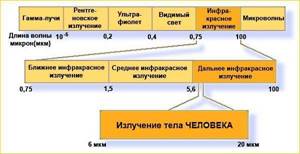
Any type of heating device used by humans emits infrared rays (IR) of varying wavelengths and intensities. Who doesn't love to bask in the warm rays of the sun? However, prolonged exposure to the sun can harm the skin. The positive and negative effects of infrared rays on a person are determined by the depth of penetration of the radiation into the skin.

Let's look at how an infrared heater works and what makes it different from other heating devices. The uniqueness lies in the fact that energy is transferred to the surface of the object with virtually no losses. The higher the temperature of the device, the hotter the heating object gets hotter. Maximum heating of the plane occurs when a large number of short waves appear, which is observed when heating the heater itself. If, during operation of the device, short waves are mainly transmitted to the heated object, the benefit parameter drops to zero, and the harm from the infrared heater increases.
There are 3 types of heaters on sale today:
- Devices heating up to 300 degrees with a wavelength of 50-200 microns.
- Devices heating up to 600 degrees with a wavelength of 2.5–50 microns.
- Devices heating up to more than 800 degrees with wavelengths of 0.7–2.5 microns.
Infrared rays with a wavelength of less than 3 microns penetrate the top layer of skin and can harm human health.
Comparative characteristics of heater manufacturers
Choosing a high-quality heater is not easy, but a comparison table with the main characteristics of the devices will help you choose the most suitable model.
| Product name | Heating area | Installation method | Weight, kg) |
| Wester IH-2000 | 40 sq.m | Ceiling | 6,8 |
| Polaris PKSH 0508H | 20 sq.m | Floor | 2,6 |
| Almac IK11 | 20 sq.m | Ceiling | 3,3 |
| Ballu BIH-L-3.0 | 30 sq.m | Wall | 4,1 |
| Resanta OM-7N | 15 sq.m | Floor | 7,4 |
| Zanussi ZOH/CS-11W | 27 sq.m | Floor | 11 |
| Polaris PRE W 1125 | 25 sq.m | Floor | 10 |
| CENTEK CT-6140 | 20 sq.m | Floor | 11 |
| Polaris PQSH 0208 | 20 sq.m | Floor | 1 |
| NeoClima NQH-1.2i | 12 sq.m | Floor | 1.2 kg |
Each heater described in this rating has sufficient functionality and reliability, so it is excellent for domestic use.
